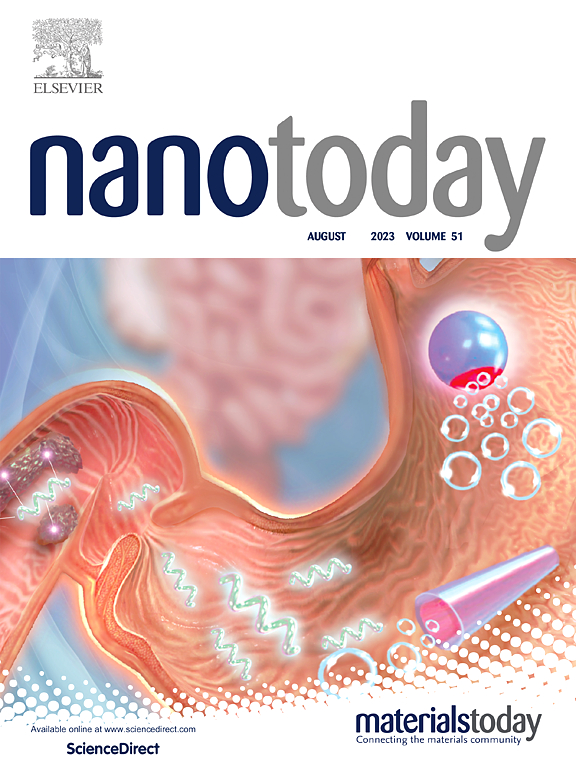“Thermal bubbles”: Photothermally triggered by a carbon monoxide nanocontainer for antibiosis and immune modulation therapy
IF 13.2
1区 材料科学
Q1 CHEMISTRY, MULTIDISCIPLINARY
引用次数: 0
Abstract
Carbon monoxide (CO) has multi-biofunctions, including antibiosis and immunoregulation, promising great therapeutic potential. However, poor controllability of releasing, unbalanced dose for antibiosis and cytocompatibility, and unexplored antibacterial mechanism, limit its practical application. To address these issues, a photo-responsive COT nanocontainer is designed on Ti by loading thermosensitive CO donors in PDA-modified TiO2 nanotubes. The nanocontainer shows outstanding photothermal properties, so as to break the Mn-CO bonds of CO donors under near-infrared (NIR) irradiation, generating thermal CO bubbles on-demand by regulating NIR power, and thus realizing different therapy modes. At antibacterial mode of COT with high-power NIR irradiation (e.g., 0.7 W cm−2), abundant hyperthermal CO bubbles from COT kill bacteria efficiently by inducing bacterial ferroptosis, which is demonstrated by hallmarks of overloaded Fe ions, lipid peroxidation, glutathione depletion, etc. At immunoregulation mode with low-power NIR irradiation (e.g., 0.3 W cm−2), mild thermal CO bubbles help macrophages to polarize into anti-inflammatory M2 phenotype, and they combine with cytokines from M2 macrophages to promote fibroblast response. These dual therapy modes of COT are verified to kill bacteria, modulate immunoreaction, and accelerate tissue repair in infected models. This study provides a controllable therapy strategy for using CO in treating infection and improving tissue regeneration.
“热气泡”:用于抗生素和免疫调节治疗的一氧化碳纳米容器光热触发
一氧化碳(CO)具有多种生物功能,包括抗生素和免疫调节,具有很大的治疗潜力。但其释放可控性差、抗生素剂量和细胞相容性不平衡、抗菌机制尚不明确,限制了其实际应用。为了解决这些问题,我们设计了一种光响应型COT纳米容器,通过在pda修饰的TiO2纳米管中加载热敏CO供体。该纳米容器具有优异的光热性能,可以在近红外(NIR)照射下破坏CO供体的Mn-CO键,通过调节近红外功率按需产生热CO气泡,从而实现不同的治疗模式。在高功率近红外照射下(如0.7 W cm−2)的COT抗菌模式下,COT产生的大量高温CO气泡通过诱导细菌铁死亡有效地杀死细菌,这表现为铁离子过载、脂质过氧化、谷胱甘肽耗竭等特征。在低功率近红外照射的免疫调节模式下(例如,0.3 W cm−2),温和的热CO气泡帮助巨噬细胞极化为抗炎M2表型,并与M2巨噬细胞的细胞因子结合促进成纤维细胞反应。在感染模型中,这些双重治疗模式被证实可以杀死细菌,调节免疫反应,加速组织修复。本研究为利用一氧化碳治疗感染和促进组织再生提供了一种可控的治疗策略。
本文章由计算机程序翻译,如有差异,请以英文原文为准。
求助全文
约1分钟内获得全文
求助全文
来源期刊

Nano Today
工程技术-材料科学:综合
CiteScore
21.50
自引率
3.40%
发文量
305
审稿时长
40 days
期刊介绍:
Nano Today is a journal dedicated to publishing influential and innovative work in the field of nanoscience and technology. It covers a wide range of subject areas including biomaterials, materials chemistry, materials science, chemistry, bioengineering, biochemistry, genetics and molecular biology, engineering, and nanotechnology. The journal considers articles that inform readers about the latest research, breakthroughs, and topical issues in these fields. It provides comprehensive coverage through a mixture of peer-reviewed articles, research news, and information on key developments. Nano Today is abstracted and indexed in Science Citation Index, Ei Compendex, Embase, Scopus, and INSPEC.
 求助内容:
求助内容: 应助结果提醒方式:
应助结果提醒方式:


